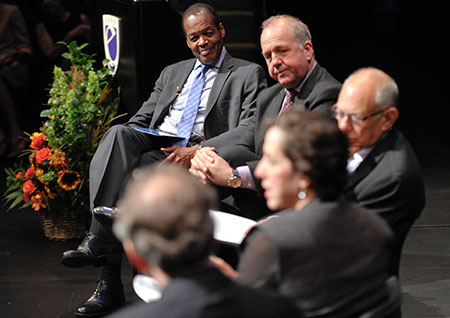ProArts Symposium spurs conversation
The role of college leaders as “content providers” to their communities was one of the ideas raised by a panel composed of the presidents of the colleges that make up Boston’s ProArts Consortium. The discussion, an inauguration week event moderated by Emerson President Lee Pelton, took place at the Semel Theater on September 13.
Emerson Vice President and Special Assistant to the President Donna Heiland opened the event by introducing the panelists: Berklee College of Music President Roger H. Brown, Boston Architectural College President Ted Landsmark, Boston Conservatory President Richard Ortner, Massachusetts College of Art and Design President Dawn Barrett, and the School of the Museum of Fine Arts (SMFA) President Chris Bratton.

The Professional Arts (ProArts) Consortium is a collective of six neighboring higher education institutions in the Boston area dedicated to the visual and performing arts.
Pelton kicked off the discussion by asking the participants about their views on higher education in the city of Boston.
Bratton of the SMFA said, “Boston is very much a part of our DNA.” He explained that his institution has a dual mission of exhibiting art and educating artists.
Ortner of The Boston Conservatory said that giving back to the Boston community is essential to the college’s mission and what sets it apart from similar institutions. Students volunteer to perform for various organizations such as the Boston Children’s Hospital.
Brown of Berklee College noted that collaboration is essential among the ProArts Consortium, especially between Emerson and Berklee. He explained that with the advent of YouTube, “collaborating between us has never been greater.” He commended all of the Consortium schools because they embody the many diverse expressions of the arts. He also took pride in how easily Boston connects internationally: “Boston allows us to bring people from around the world to study.”
Pelton described Boston as a “cultural center” and invited panelists to discuss culture and its importance.
Barrett of Massachusetts College of Art observed that “culture is a part of the human condition… you don’t have society without a cultural component.” Ortner said that there is a “basic human impulse to share stories, to create metaphor… [and that] culture helps us speak to one another about those things.” Ortner believes that as institutional leaders, they are the “content providers” to their communities.
Landsmark of Boston Architectural College described culture as “the essence of what humanity is.” He went on to say that the downside to culture is that sometimes those outside of it are excluded, violently so, and that cultures need to be fundamentally tolerant of other cultures, in order for everything to survive.
During the question and answer period, Emerson Vice President for Information Technology Bill Gilligan asked if the future looked bright for technology and the arts. Brown spoke about how some Berklee music courses are now taught online. What once was thought impossible—instruction that needed one-on-one attention—has been transformed into online courses, he said.
Many of the panelists expressed how the digital development of courses is in its infancy in terms of potential, and that some of the earliest adopters of new technology are often artists and musicians.
Categories